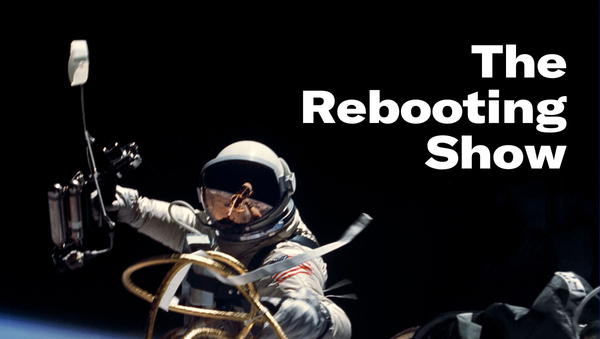How Puck is putting creators at the center of a media brand
COO Liz Gough on the sweet spot between institutional and personal brands
Subscribe on Apple Podcasts and Spotify If you use Apple, please leave a rating and review.
Every cycle of unbundling is followed by another period of rebundling. Media is no different – just look at the streaming market. In publishing, the shift of power from institutional brands to individual brands has unfolded over the past few years, and now a period of rebundling will begin.
Puck is a seven-month-old media brand built with the institutional-individual brand continuum firmly in mind. The publication has recruited several well-known journalists to focus on American power centers in finance, tech, media, politics and entertainment.
“Puck is a media brand with creators at the center,” said Liz Gough, a former Condé Nast exec who is COO of Puck. “We are focused on telling the inside story from some of the most important parts of America: Wall Street, Silicon Valley, Washington DC and Hollywood.”
What I’ve liked about Puck is how it’s not recreating the same old publishing model but instead bringing on its contributors – people like Dylan Byers, Julia Ioffe, Teddy Schleifer, Matt Belloni – as partners, giving them a middle ground that has the benefits of both the institutional approach and personal brand approach. (I have a deal with Puck as a contributor to license some of my writing for The Rebooting. I don’t have any financial interest in the company beyond that.)
“We saw two ends of the spectrum,” Liz said. “We saw the individual brands of the world and at the other end legacy or institutional brands that a lot of the founding team at Puck came from and have their own amazing benefits but also challenges. We thought the media brand of the future is taking the best of both of those worlds.”
In this week’s episode of The Rebooting Show, Liz and I discuss the idea of journalists as influencers, why subscriptions and ads work well together and power centers as an editorial lens.
Journalists as influencers
The notion of “personal brands” in journalism is, to put it mildly, a bit of a lightning rod, but Puck doesn’t shy from the concept. After all, journalists have long built reputations for their work – and looked to make money from those reputations.
“Journalists are the one of the most original influencers in American society when you think about it. They were the last untapped group in the direct-to-consumer revolution. We started thinking about how to build a business that places journalists at the center of the revenue model rather than as a cost center. But at the same time, we know brand still matters.”
No one size-fits-all-approach
I’m not a big fan of false dichotomies. There’s no one way to do anything, or one model for publishing. What I think the unbundling of publishing has done – and I give Substack a lot of credit for opening new options – is to give writers more choices about how they work. The idea that many people don’t all have the same needs and motivations doesn’t strike me as crazy – new options are a good thing.
“This industry and it's constantly reinventing itself. We’re at a point now where journalistic creators have more options than they’ve ever had in terms of where they can create content, if they’re an individual brand or a niche brand like Puck or they’re part of an institutional brand. It’s all about each individual’s risk tolerance and desire for autonomy and where they want to work and how they want to work. Do they want an editor? Do they want advertising sales? It’s a great time to figure out what works best for you and what helps you maximize your creativity.”
Subscriptions and ads work best together
Puck is a subscription-based publication, but not subscription-only. Since its launch, Puck has run ads from 15 brands, including Facebook, and ads make up half of the company’s revenue. After all, advertising is still a great business model for publishers. With one in four of Puck’s audience identifying as a senior executive, it can get around scale questions and lean on the influence of its subscribers.
“We love ads. I've spent my whole career working in media on the business side, so I understand their importance and what they can do for our client partners. We are approaching everything with a subscriber-first mindset because people are paying for our product. We’re careful not to do anything just to sell it. We had some client partners ask if we can do a dedicated email. We don’t think that’s something at the moment we could create that our subscribers would find useful. We’re trying to make every business decision based on if it will benefit our subscribers or give them something additive to their experience.”
Focusing on power
Puck is a brand that is focused on the most influential people and industries in American society. I’ve written about the benefits and risks of this rich niche focus that many publications have. As a business, the upsides are clear in not only the ability to charge for content but the ability to attract high-priced advertising without having to reach massive audience numbers. For Puck, the different power centers end up overlapping.
“Those different worlds of power are all conjoining. Tech and Hollywood are in some cases becoming one and the same. At the top of the pyramid, all of those worlds are interconnected. It’s one room, and Puck is the narrator from that room. We hope as we grow that we’re expanding the concentric circles around those people in the room.”

5 things to check out
It’s not being paranoid if they really are out to get you. You can forgive publishers for feeling programmatic ad systems are often rigged against their interests. That’s because there are many cases where this proves true. Ryan Barwick details how publishers are finding “brand safety” vendors use their presence on their sites – often required by ad buyers – in order to create contextual ad segments.
Launching a publishing brand is a different proposition these days. No longer is the website the starting point, as Troy Young notes. There’s still room for the site, which is great as a hub and for search and other indirect traffic, but I don’t think primary-engagement media needs the site as a focal point.
The news industry isn’t above using dark patterns to further their businesses. Mark Stenberg goes through many of the most annoying tactics used against audiences. These kinds of adversarial moves have long been shrugged off as part of the game, but the long-term cost is a loss of trust and loyalty.
The return to office battle is just beginning. The office has always been a blunt instrument, ideal for some and a hellscape for others. Companies mandating blanket orders to return to cubicle life are finding many workers are just not showing up.
Huckberry is looking for a director of content. The men’s clothing and gear retailer has a growing media operation. As my former colleague Shareen Pathak writes about at Toolkits, more companies are setting up legitimate content operations as they look to both build their brands and lower their customer acquisition costs. The job is based in Austin.

Let me know what you think about this week’s episode by hitting reply to this email. If you’re interested in sponsoring The Rebooting, check out the sales kit and get in touch: bmorrissey@gmail.com.




